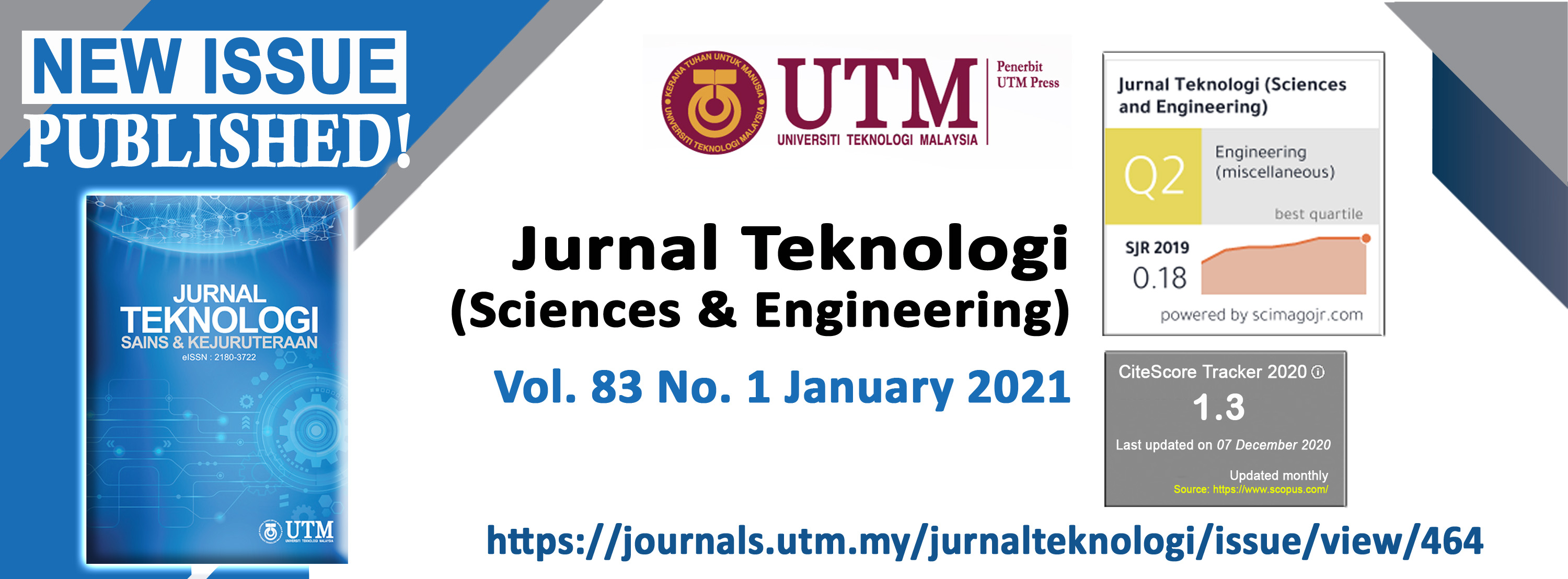ASSESSMENT OF THE ACCURACY AND PRECISION OF MyRTKnet REAL-TIME SERVICES
DOI:
https://doi.org/10.11113/jurnalteknologi.v83.13892Keywords:
MyRTKnet, SpiderNet, GDM2000, ITRF2014, post-processedAbstract
From a network of ninety-six (96) Continuously Operating Reference Stations (CORS), the Department of Survey and Mapping Malaysia (DSMM) has developed a reliable real-time data streaming service known as the Malaysia Real-Time Kinematic GNSS Network (MyRTKnet). MyRTKnet is now operating on Leica SpiderNet system that is configured to provide coordinate to users in Geocentric Datum of Malaysia 2000 (GDM2000). As the name implied, GDM2000 is a geocentric datum for Malaysia, developed based upon the International Terrestrial Reference Frame (ITRF) 2000 or ITRF2000. One could argue that the quality of coordinates provided by MyRTKnet are less optimal as the latest realisation of ITRF at present is ITRF2014. This study aims to investigate the accuracy and precision of the resultant coordinates from MyRTKnet real-time services through a comparison with the control-quality coordinates from a network of post-processed data at some independent points for positioning purpose. Meanwhile for mapping purpose, the coordinates from Network Real-Time Kinematic (NRTK) at selected Cadastral Reference Marks (CRM) points were compared with their known values. The results show that the observed points in ITRF2000 move approximately 37 cm away from the points in ITRF2014 due to the constant movement of Sundaland Block. Meanwhile for the assessment of NRTK technique, there is no significant displacement for coordinates in ITRF2000 but ITRF2014 with the values of 4.4 and 39.8 cm at KDOJ point, respectively. The discrepancy in ITRF2014 could be due to the improper datum transformation procedure.
References
Berber, M., & Arslan, N. (2013). Network RTK: A case study in Florida. Measurement, 46(8), 2798-2806
Rizos, C. (2002). Network RTK research and implementation: A geodetic perspective. Journal of Global Positioning Systems, 1(2), 144-150.
Kadir, M., Ses, S., Omar, K., Desa, G., Omar, A. H., Taib, K., & Nordin, S. (2003). Geocentric datum GDM2000 for Malaysia: Implementation and implications. In Seminar on GDM2000, Department of Survey and Mapping Malaysia, Kuala Lumpur, Malaysia (Vol. 28).
Gill, J., Shariff, N. S., Omar, K. M., Din, A. H. M., & Amin, Z. M. (2016). Development of a Time-Dependent 3-Parameter Helmert Datum Transformation Model: a Case Study for Malaysia. International Archives of the Photogrammetry, Remote Sensing & Spatial Information Sciences, 42.
Yusoff, M. Y. M., Jamil, M. H., & Halim, M. N. Z. A (2013). eKadaster: A Learning Experience for Malaysia. In FIG Pacific Small Island Developing States Symposium, University of Technology Malaysia,6367.
Choon, T.L, and Seng, L.K (2013). Developing Infrastructure Framework for 3D Cadastre. Paper of Department of Survey and Mapping Malaysia,4-13.
Department of Survey and Mapping Malaysia (DSMM) (2016): Perkhidmatan MyRTKnet di Bawah Platform SpiderNet. Pekeliling Ketua Pengarah Ukur dan Pemetaan
Berber, M., Ustun, A., & Yetkin, M. (2012). Comparison of accuracy of GPS techniques. Measurement, 45(7), 1742-1746
Altamimi, Z., et Forestière, G., & IGN, F. (2012, November). Role and importance of the International Terrestrial Reference Frame (ITRF) for sustainable development. In ICG-7: Seventh Meeting of the International Committee on GNSS, Beijing, China.
Sincich,T.(1996). Business statistics by example. [Beiheft]. Computer software tutorials: [SAS, SPSS, MINITAB, ASP]. Prentice Hall.
Edwards, S. J., Clarke, P. J., Penna, N. T., & Goebell, S. (2010). An examination of network RTK GPS services in Great Britain. Survey Review, 42(316), 107-121.
Harikumar, G., Karthikeyan, K., Syamala, S., Pillai, C. R., Hemachandran, S., Shukkoor, A. A., & Mohanlal, P. P. (2013). Troposphere induced GPS navigation error, its effect on GPS-INS integrated system performance and mitigation strategies. 92.60. hf; 84.40. Ua; 91.10. Fc.
C. Wang, Y. Feng, M. Higgins, and B. Cowie (2010) “Assessment of commercial network RTK user positioning performance over long inter-station distances,†Journal of Global Positioning Systems, vol. 9, no. 1, pp. 78–89.
R. Odolinski, (2012)“Temporal correlation for network RTK positioning,†GPS Solutions, vol. 16, no. 2, pp.147–155
Downloads
Published
Issue
Section
License
Copyright of articles that appear in Jurnal Teknologi belongs exclusively to Penerbit Universiti Teknologi Malaysia (Penerbit UTM Press). This copyright covers the rights to reproduce the article, including reprints, electronic reproductions, or any other reproductions of similar nature.
















